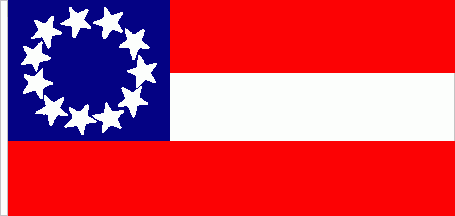Flags of the Confederate States Navy

Illustration of a three masted ship demonstating
placement of the ensign, commission pennant, and jack.
by Devereaux D. Cannon, Jr., 05 February 2000
The Navy Ensign
Navies have their own specific flags and flag terminology. The principal flag denoting nationality on any ship, whether naval or civilian, is called the ensign.

Ensign of the CSS Virginia
by Devereaux D. Cannon, Jr., 05 February 2000
from a sketch by Howard M. Madaus
The ensign of the Confederate States Navy was the same as the national flag, that pattern from 1861 to 1863 being the design known as the Stars and Bars. It was flown from the stern of a ship, usually from a gaff on ships rigged for sail, and on an ensign staff on steamers without sails and ironclad gunboats.
Like the flag as used on land, Stars and Bars navy ensigns are found with a variety of numbers of stars and patterns of arrangement. Navy ensigns will have from seven to thirteen stars. They are more likely than their land-bound counterparts to follow the official requirement that the stars be in a circle, though often that circle will surround a central star. There are, however, variations from the circular pattern.
Devereaux D. Cannon, Jr., 05 February 2000
The Commission Pennant

CS Navy Commission Pennant, 1861
by Devereaux D. Cannon, Jr., 05 February 2000
A commission pennant indicates that the ship on which it is flown is commissioned in the naval service of its government. Only naval vessels (or in some cases, other vessels in government service) fly a commission pennant. In the Confederate States Navy, the commission pennant of 1861 was based upon the Stars and Bars national flag. Since the Stars and Bars itself derived its design from the Stars and Stripes of the United States, the CS Navy commission pennant for the 1861-1863 period was very similar to the US Navy pennant. There are no extant regulations for CS Navy flags from the 1861-1863 period. We can, however, make an educated guess about the commission pennant from surviving sources.
Where the US Navy pennant had a union with 13 stars (7 for smaller boats), with the balance of the pennant being two stripes of red and white, the CS Navy pennant apparently had stars corresponding in number to the States in the Confederacy, and three stripes of red, white, and red. Depending upon the time of manufacture, like the ensign, the pennant could have had from seven to thirteen stars.

Commission Pennant of the CSS McRae
by Devereaux D. Cannon, Jr., 05 February 2000
from a sketch by Howard M. Madaus
There is only one surviving CS Navy commission pennant of this type. The pennant of the CSS McRae has ten stars in its blue union, and three stripes. The lower red stripe is very narrow, and suggests that this pennant may have been made from an altered US Navy commission pennant.

Commission Pennant as illustrated in
Memoirs of Service Afloat by Admiral Raphael Semmes, CSN
by Devereaux D. Cannon, Jr., 05 February 2000
One other piece of evidence about the design of the commission pennant for this period is found in Memoirs of Service Afloat during the War Between the States, by Admiral Raphael Semmes, CSN. Facing page 124 is a plate with portraits of some of the officers of the CSS Alabama. Included among the naval vignets on that plate are two commission pennants as illustrated above. These pennats each have eight stars arranged in two rows of four each on the blue union, with the red, white, red stripes making up the balance of the pennants.
Devereaux D. Cannon, Jr., 05 February 2000
The Navy Jack

Jack of the CSS Atlanta
by Devereaux D. Cannon, Jr., 05 February 2000
from a sketch by Howard M. Madaus.
A jack is a small flag flown at the bow of a ship. It is not flown while the ship is at sea, but only when at port, or while entering or leaving a port. The staff from which a jack is flown is often removed when the ship is underway. It is said that this was to keep it clear of the forward field of fire in combat.
By tradition inherited from the Royal Navy, the jack of the US Navy is the union of the ensign. The CS Navy carried forward this tradition. As a result, since in the 1861-1863 period the ensign was the Stars and Bars, the jack was a plain blue flag charged with white stars. Except for the number of stars, it was identical to the jack of the US Navy.
The only known surviving jack of this period is the one illustrated above from the CSS Atlanta. It has only seven stars, and although on board the Atlanta when it was captured in June 1863, may date to an earlier period. Like the ensign, jacks in use in this period probably could be found with star numbers ranging from seven to thirteen.
Devereaux D. Cannon, Jr., 05 February 2000